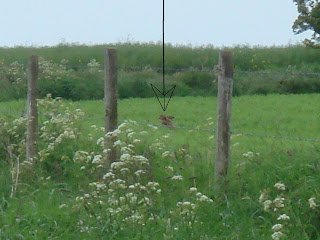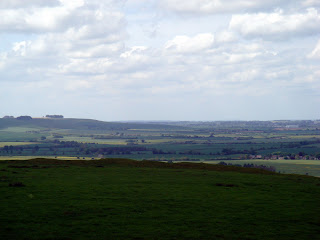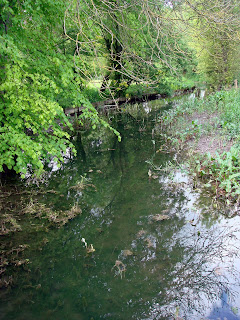 A new day, a new section of the Ridgeway path. My car having been left
A new day, a new section of the Ridgeway path. My car having been leftin a handy pub car park I climbed, in a slight drizzle at first,
up the slope onto Fox Hill (with the radio mast.
This is a "whence I have come" shot with the Marlborough Downs and the
various clumps of trees on the furthest ridge and Liddington castle just near
to the little tuft of trees in the middle!) .
Once again the pathway was pleasingly edged with thick hedgerow
and this good days walk was one to have plenty of wildlife, and flora.

Campion
a plethora of species.
 Of bird life, their were lots of whitethroats (above)with their scratchy songs, yellowhammers,
Of bird life, their were lots of whitethroats (above)with their scratchy songs, yellowhammers,
 Todays big features, however, were further ancient ones. First of all
Todays big features, however, were further ancient ones. First of all
I reached Wayland's Smithy, a large long barrow burial site dating back
 Wayland (oe Weland) the Smith was an Anglo-Saxon god/elf who (they supposed)
Wayland (oe Weland) the Smith was an Anglo-Saxon god/elf who (they supposed)

 White horse??
White horse??

 Of bird life, their were lots of whitethroats (above)with their scratchy songs, yellowhammers,
Of bird life, their were lots of whitethroats (above)with their scratchy songs, yellowhammers,a bullfinch (which is the first one I have seen for some time!), goldfinches, corn buntings, sky larks (of course), meadow pipits, blue and great tits, lapwings and red-legged partridges. There were also buzzards, a kestrel and (rather surprisingly I thought)
herring gulls (I couldn't help thinking of Keehar in "Watership Down" with his German "Yah!Yah!" in the animated version....heehee!) . As for mammals...well one dear, one (very quick glimpse ) bank vole, and rabbits. Domestically, of course, there were also sheep a-grazing, pigs a-squealing...And then, of course, there was an occasional curious heifer.
This one stopped by to help me located myself on the map. (I was interested in the abrupt occurance of the little dry valley in the background.)
 Todays big features, however, were further ancient ones. First of all
Todays big features, however, were further ancient ones. First of allI reached Wayland's Smithy, a large long barrow burial site dating back
to ahout 3000bc.
 Wayland (oe Weland) the Smith was an Anglo-Saxon god/elf who (they supposed)
Wayland (oe Weland) the Smith was an Anglo-Saxon god/elf who (they supposed)would re-shoe your horse for you here overnight, if your left the horse and a coin
here. More information here:
rest no doubt. I, however, had to be on my way once more.
the next site of interest was approached soon after a throng of school children
and accompanying adults passed me by, on their way to the Smithy, no doubt.
"I timed that well" I thought to myself!
So "Where to next?" you ask
Yes. Another hill fort on the horizon....

 White horse??
White horse??Yes!!
White horse indeed!
The White horse of Uffington
Oldest and biggest of the lot.
Oldest and biggest of the lot.

The horse is gracefully sprawling on a (relatively) gentle slope of the scarp face, and tantilisingly impossible to view fully at close range, except from the air.
see this LINK for clearer views and more detail!!



























